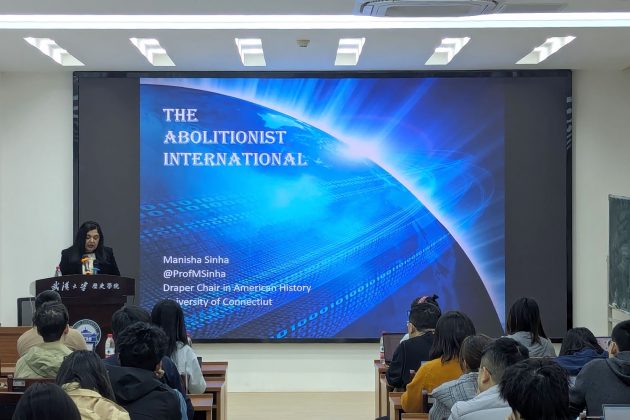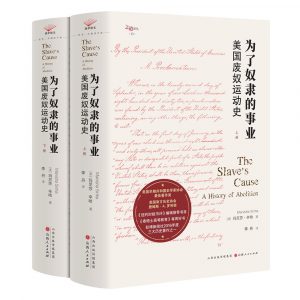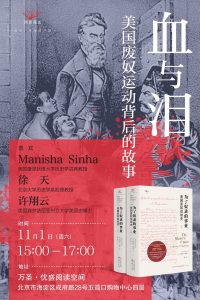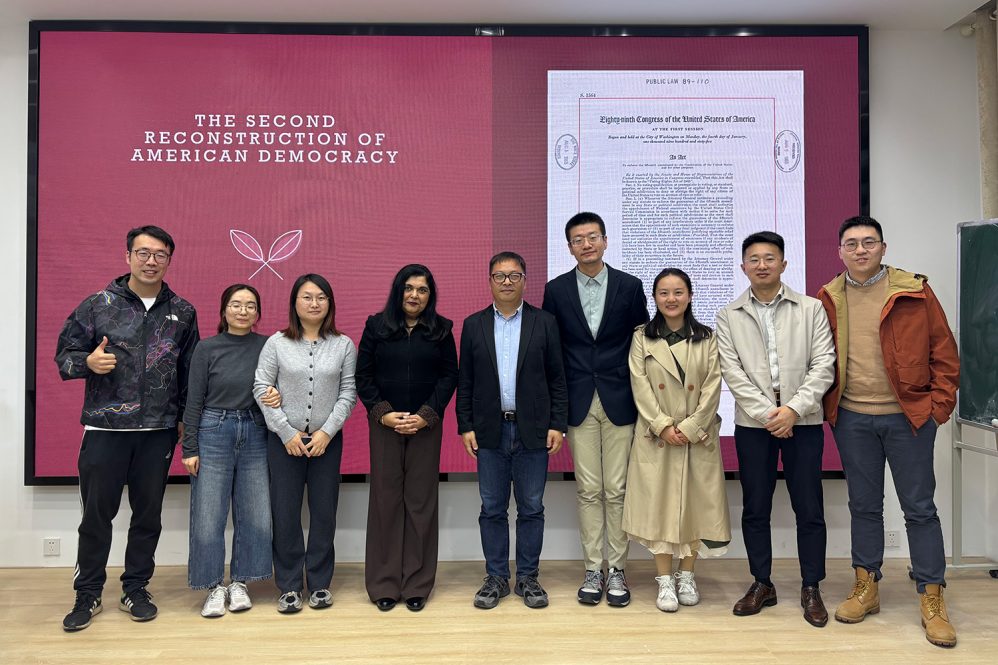In November, Manisha Sinha, the James L. and Shirley A. Draper Chair in American History, returned from a lecture tour in China marking the Chinese-language launch of her award-winning book, “The Slave’s Cause: A History of Abolition” (Yale University Press, 2016).
A groundbreaking history of abolition, “The Slave’s Cause” recovers the largely forgotten role of African Americans in the movement for emancipation from the American Revolution through the Civil War. The book was widely celebrated, earning the Frederick Douglass Book Prize, awards from the Organization of American Historians and the Southern Historical Association, and a spot on the long list for the National Book Award for Nonfiction.
Sinha’s visit included a book launch in Beijing and lectures at Wuhan University, Shanghai Normal University, East China Normal University, and Peking University. Her talks examined the global history of abolition and the legacy of slavery, as well as her latest book, “The Rise and Fall of the Second American Republic: Reconstruction, 1860-1920” (Liveright, 2024).
We caught up with Sinha to discuss her experience and the global reach of her scholarship.

How did the Chinese-language edition of your book come about?
Our publisher, Beijing Han Tang Zhi Dao Book Distribution Co., Ltd., acquired the rights directly from Yale University Press a few years ago. It took some time to get the translation right. The publisher worked with Lu Dan, a Chinese academic, and the book was published in two volumes.
We launched the book in Beijing. I also did a lecture tour starting with two talks at Wuhan University, where they invited Americanists from all over the country. Traveling to all these countries, you realize that there are a large number of Americanists working on U.S. history abroad. You wouldn’t think there were more than 100 historians studying the United States in China, but it was amazing to see the turnout.
What does the Chinese-language translation of the “The Slave’s Cause” mean to you?
My book is about American abolition, but also Anglo-American abolition and the global context of the movement, so it has a wide reach. It was such a long book that I thought no one would read it! I worked on it for over a decade. It was a passion project for me, so it’s incredibly gratifying to see it being read and reviewed all over the world.
When it first came out, I did a book tour of Britain and gave talks at the British Library, University College London, Oxford University, Cambridge University, and the University of Edinburgh. I also went to France, Germany, India, and Australia, and gave keynote lectures at several international conferences. They spoke English in all those places, so the book wasn’t translated into German or Dutch. The French civil service made it required reading for their Agrégation examination, but they had to read the whole thing in English. So, the Chinese translation means a lot.

Why do you think the book has such international appeal?
Two of my main contributions have been reframing abolition not as a Northern, white, middle-class movement, but as one rooted in the resistance of Black people themselves, both free and enslaved, who were at the heart of abolition. They were central to shaping the movement’s ideas and tactics in the United States. It was a radical, interracial movement led by ordinary people, men and women, Black and white. That part of the book has been especially popular here and has also drawn attention abroad.
But there’s another part of the book, the “Abolitionist International,” that examines how American abolitionists were also deeply committed to causes beyond the U.S. Many were involved in the international peace movement, pacifism, utopian socialism, and efforts to address the ills of industrialization. They were anti-imperialists and critics of the British Empire. They criticized the Opium Wars in China and condemned the treatment of Chinese immigrants on the U.S. West Coast. Most other histories didn’t examine that.
What themes did you focus on during your talks in China?
I mainly spoke about the radical, overlapping movements that influenced American abolitionists and about their critique of imperialism. My audiences were interested in questions of American democracy, the China connection, and how my book has changed historical scholarship on the movement in the United States. Chinese scholars had also learned from their textbooks that the abolitionist movement was paternalistic, economically conservative, religious, and middle class. They were eager to get a more complex view of the movement.
Were there any questions or discussions during your lectures that stood out to you?
Most of the questions were about my book and about studying in the U.S. The most striking ones came from people who were deeply concerned about the attacks on higher education. They’re Americanists, so they look up to the U.S. higher education system as a model. They had studied at universities all over the U.S. They were perplexed by the fact that funding is being taken away from both scientific and historical research, because China is doing the opposite.
What does it mean to you to have this book launched in China right now?
It’s very heartening. I think people need to know that, yes, the history of the United States includes slavery, but it also includes ordinary Americans rising up against slavery and against the Slave Power that dominated before the Civil War. The United States is not hypocritical; people have always fought both on the side of injustice and against it. That message feels especially important now, when it can sometimes seem like we’re moving backward. I wanted to share that message with Chinese audiences, because their country is also grappling with some of those same questions.

You’re currently on sabbatical. What projects are you working on now?
I’ve always been interested in women’s rights, gender, and inequality. “The Slave’s Cause” looked at how the first women’s rights movement emerged from the abolitionist movement. My latest book looks at women’s suffrage and ends with the 19th Amendment. For my next project, I want to do a global history of feminism, beginning with antiquity before modern feminism. There are women from this period who are largely unknown. One of them is Ban Zhao, a female intellectual from China’s Han Dynasty who advocated for women’s education. I also want to talk about Africa, medieval Europe, Ancient Greece.
I’m fortunate to have a full-time research assistant, history Ph.D. student Mamiri Imai, who is helping me with this project, thanks to the James L. and Shirley A. Draper Endowment. The Draper Chair is a real godsend. I would not have been able to write my last book without that support. The endowment not only advances my research, it also helps me support initiatives like a Reconstruction conference at UConn and strengthen our department by attracting students interested in early American history.
How does international engagement influence your teaching at UConn?
At the graduate level, this kind of international engagement is very direct. I make connections with people abroad, and some come to work with me at UConn or apply to our Ph.D. program.
At the undergraduate level, it helps me with my teaching. I always have two or three exchange students from Britain and Scotland in my Civil War class. It allows me to discuss the war in a more international terms beyond the textbook version, and that also helps the American students.
I want students to know that 19th-century Americans were aware of what was happening around the world. Lincoln offered a real critique of nativist feelings. It helps students understand that people in the 19th century were grappling with many of the same issues we’re wrestling with today, and they had opinions about it. It brings a larger perspective to being citizens not only of this country but of the world.
Next year, I’m teaching a course on the American Revolution to mark the 250th anniversary of the American republic. The revolution was a world-historic event, the first successful anti-colonial revolution. A lot of countries fighting for freedom in the 20th century still looked back at it as the first defeat of European imperialism. I want my students to have that global perspective on the American Revolution.



